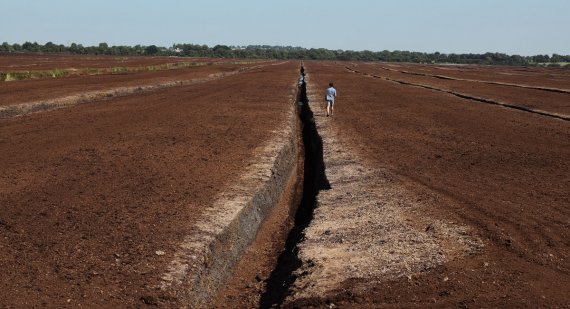Peat extraction in the Irish Midlands. © Brian MacDomhnaill
Van Beek (Soil Geography and Landscape; Cultural Geography) is a landscape archaeologist. In 2009, he wrote a monumental thesis (695 pages!) about the long-term development of the landscape in the eastern part of the Netherlands. Two years ago, he received a Vidi grant to study the cultural significance of bog landscapes in the Netherlands. ‘How did people handle bogs over the centuries? How did bogs affect man? From a spiritual place for sacrifices (the bog bodies!) to reclamation and peat extraction.’
Endangered
Part of the project consists of a bog reconstruction. Van Beek: ‘How did these bogs develop? Did they grow evenly or in stages? We still know very little on the subject.’ However, it is clear that these are endangered landscapes. ‘Only five percent of the original bogs is left. But these include very special landscapes. Special from an archaeological point of view, but also culture-historically and ecologically.’
The recently awarded European project (Wetfutures) is an extension of the bog research. Van Beek is leading an international project that examines how the dynamics of wetlands affect the peculiar heritage in those areas. The focus in the Netherlands is on the Wadden Sea, Schokland and the peaty meadow area in the southwestern part of the Netherlands. The English partner (Bradford University) studies the Somerset Levels and the estuary of the Humber, among others, while the Irish partner (University College Cork) focuses on the Midlands.
These are contested landscapes, areas where various groups have interests which are often incompatible.
Roy van Beek
The aim of the European project is to map the dynamics of different wetlands. Economic and demographic developments and climate change threaten to profoundly affect the wetlands and their cultural significance. ‘These are contested landscapes, areas where various groups have interests which are often incompatible. The project aims to map that. With the ultimate goal being to better deal with this in policy.’
Wetfutures
Wetfutures is a European JPI project (Joint Programming Initiatives). The two-year project involves half a million euros, half of which is meant for WUR research. With these funds, Van Beek can appoint a postdoc and a research assistant. Besides Van Beek, one other colleague works on the project: Maarten Jacobs (Cultural Geography).

